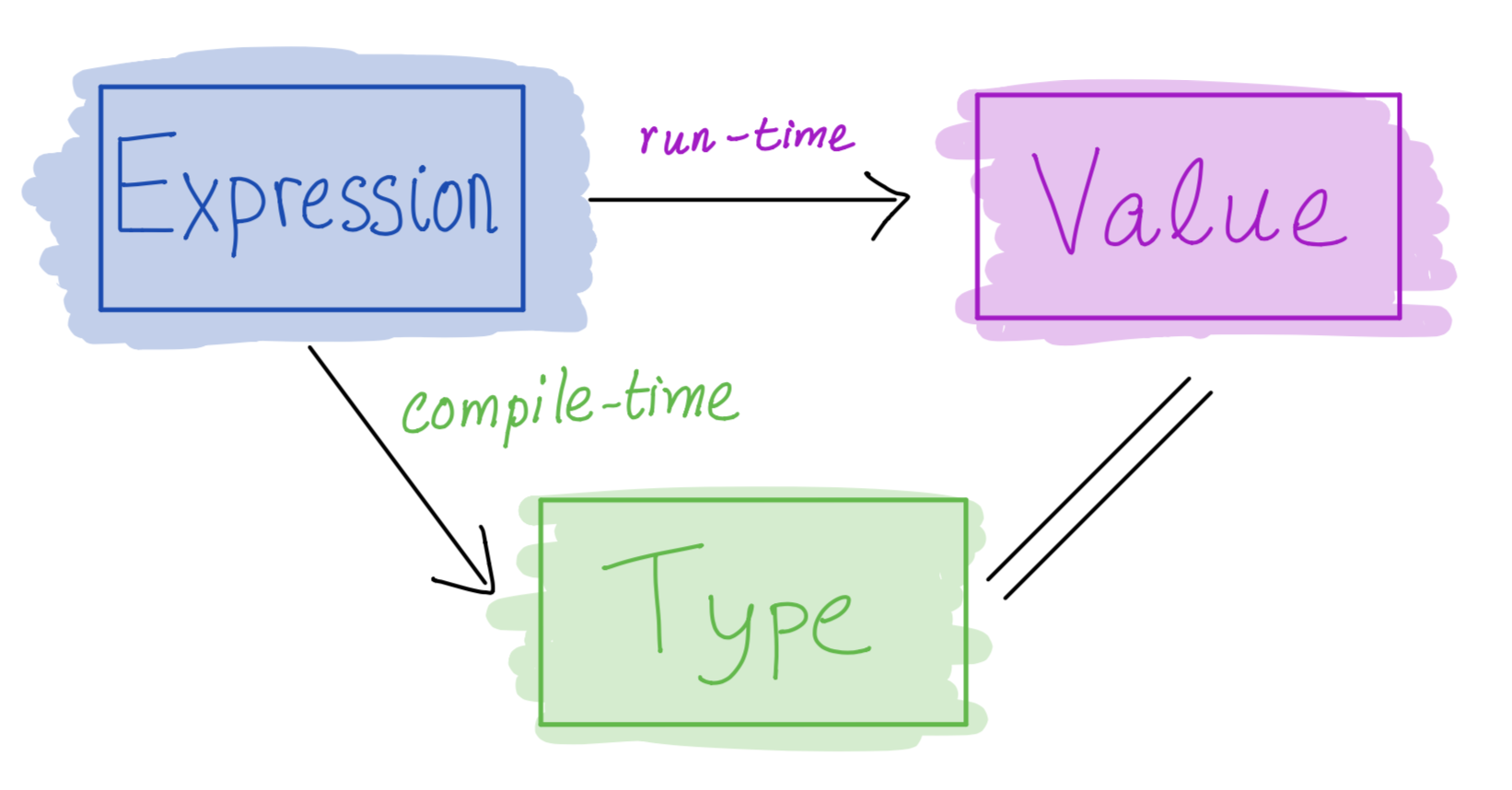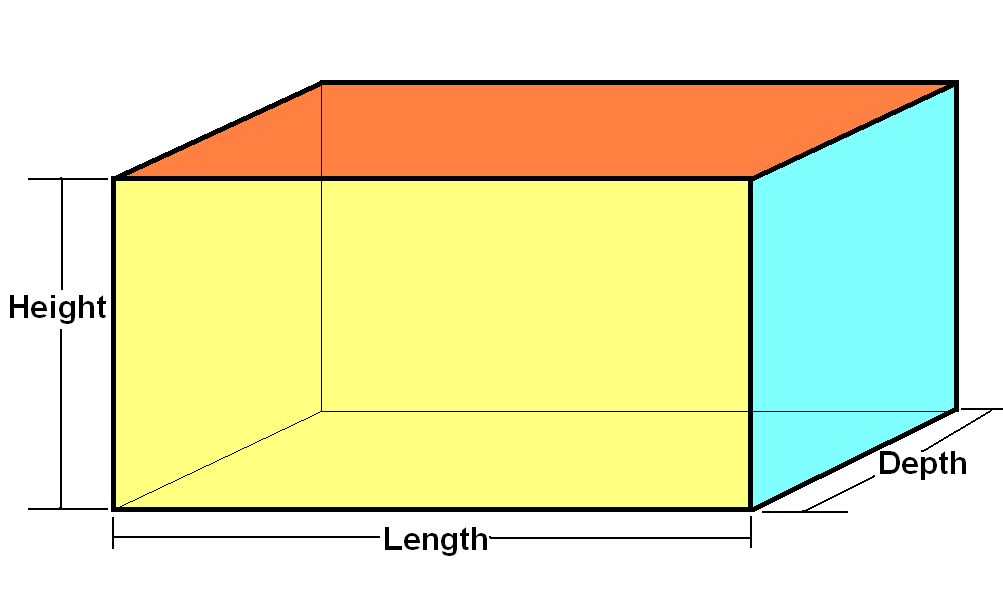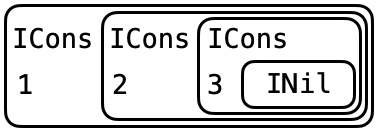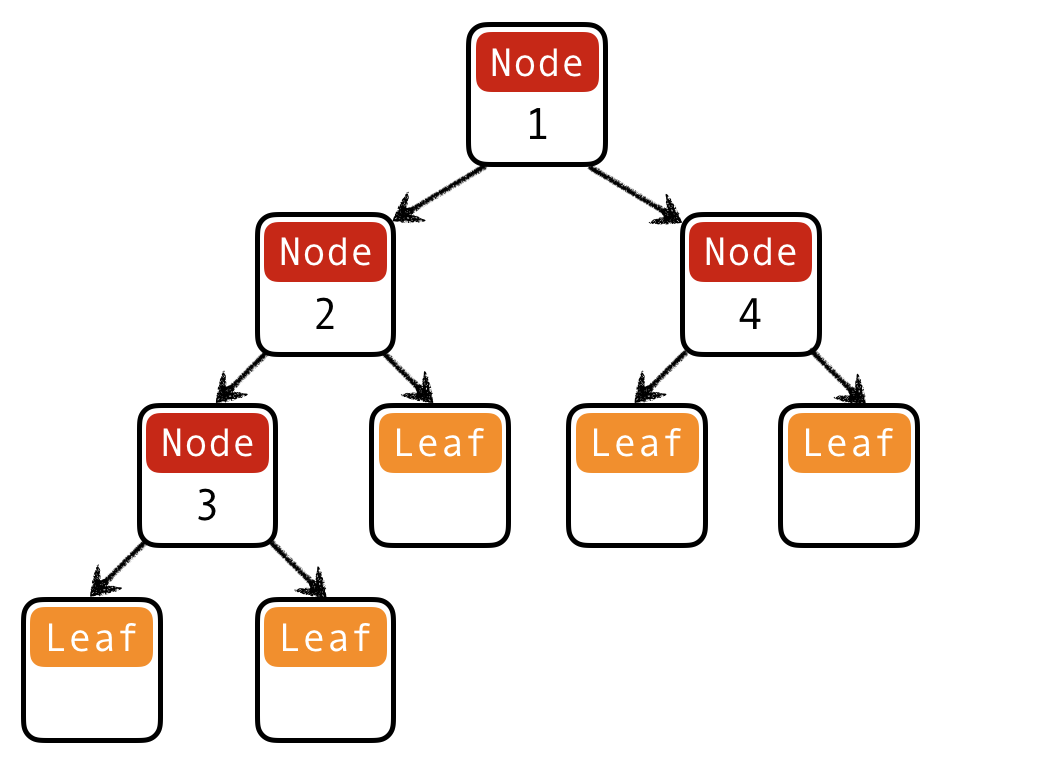Recap: Haskell Crash Course

- Core program element is an expression
- Every valid expression has a type (determined at compile-time)
- Every valid expression reduces to a value (computed at run-time)
Representing complex data
We’ve seen:
base types:
Bool,Int,Integer,Floatsome ways to build up types: given types
T1, T2- functions:
T1 -> T2 - tuples:
(T1, T2) - lists:
[T1]
- functions:
Algebraic Data Types: a single, powerful technique for building up types to represent complex data
- lets you define your own data types
- subsumes tuples and lists!
Algebraic Data Types
Type Synonyms: naming existing types
Product Types: bundling things together
Sum Types: types with multiple variants
Recursive Types: types that contain themselves
Polymorphic Datatypes: datatypes with parameters
Type Synonyms
Synonyms are just names (“aliases”) for existing types
- think
typedefinC
A type to represent circles
A tuple (x, y, r) is a circle with center at (x, y) and radius r
type CircleT = (Double, Double, Double)
A type to represent cuboids
A tuple (length, depth, height) is a cuboid
type CuboidT = (Double, Double, Double)
Using Type Synonyms
We can now use synonyms by creating values of the given types
circ0 :: CircleT
circ0 = (0, 0, 100) -- circle at "origin" with radius 100
cub0 :: CuboidT
cub0 = (10, 20, 30) -- cuboid with l=10, d=20, h=30 And we can write functions over synonyms too
area :: CircleT -> Double
area (x, y, r) = pi * r * r
volume :: CuboidT -> Double
volume (l, d, h) = l * d * h We should get this behavior
>>> area circ0
31415.926535897932
>>> volume cub0
6000
QUIZ
Suppose we have the definitions
type CircleT = (Double, Double, Double)
type CuboidT = (Double, Double, Double)
circ0 :: CircleT
circ0 = (0, 0, 100) -- circle at "origin" with radius 100
cub0 :: CuboidT
cub0 = (10, 20, 30) -- cuboid with length=10, depth=20, height=30
area :: CircleT -> Double
area (x, y, r) = pi * r * r
volume :: CuboidT -> Double
volume (l, d, h) = l * d * hWhat is the result of
>>> volume circ0A. 0
B. Type error
Answer: A
Beware!
Type Synonyms
Do not create new types
Just name existing types
And hence, synonyms
- Do not prevent confusing different values
Algebraic Data Types
Type Synonyms: naming existing types [done]
Product Types: bundling things together
Sum Types: types with multiple variants
Recursive Types: types that contain themselves
Polymorphic Datatypes: datatypes with parameters
Creating New Data Types
We can avoid mixing up values by creating new data types
-- | A new type `Circle` with constructor `MkCircle`,
-- which takes three arguments of type `Double`
data Circle = MkCircle Double Double Double
-- | A new type `Cuboid` with constructor `MkCuboid`
-- which takes three arguments of type `Double`
data Cuboid = MkCuboid Double Double DoubleWe use constructors to build values of the new type:
circ1 :: Circle
circ1 = MkCircle 0 0 100 -- circle at "origin" w/ radius 100
cub1 :: Cuboid
cub1 = MkCuboid 10 20 30 -- cuboid w/ len=10, dep=20, ht=30
QUIZ
Suppose we create a new type with a data definition
-- | A new type `Circle` with constructor `MkCircle`
data Circle = MkCircle Double Double DoubleWhat is the type of the MkCircle constructor?
A. MkCircle :: Circle
B. MkCircle :: Double -> Circle
C. MkCircle :: Double -> Double -> Circle
D. MkCircle :: Double -> Double -> Double -> Circle
E. MkCircle :: (Double, Double, Double) -> Circle
Answer: D
Aside: Record syntax
Haskell’s record syntax allows you to name the constructor parameters:
Instead of
data Circle = MkCircle Double Double Doubleyou can write:
data Circle = MkCircle { center_x :: Double, center_y :: Double, radius :: Double }then you can do:
circ1 = MkCircle { center_x = 0, center_y = 0, radius = 100 } -- same as: circ1 = MkCircle 0 0 100 r = radius circ1 -- use field name as a function
QUIZ
Suppose we have the definitions
type CuboidT = (Double, Double, Double)
data Cuboid = MkCuboid Double Double Double
volume :: CuboidT -> Double
volume (l, d, h) = l * d * hWhat is the result of
>>> volume (MkCuboid 10 20 30)A. 6000
B. Type error
Answer: B
Deconstructing Data
Constructors let us build values of new type … but how to use those values?
How can we implement a function
volume :: Cuboid -> Double
volume c = ???such that
>>> volume (MkCuboid 10 20 30)
6000
Deconstructing Data by Pattern Matching
Haskell lets us deconstruct data via pattern-matching
volume :: Cuboid -> Double
volume (MkCuboid l d h) = l * d * h
area :: Circle -> Double
area (MkCircle x y r) = pi * r * rsame as for tuples, just using different constructors!
Algebraic Data Types
Type Synonyms: naming existing types [done]
Product Types: bundling things together [done]
Sum Types: types with multiple variants
Recursive Types: types that contain themselves
Polymorphic Datatypes: datatypes with parameters
Defining new types with data prevents us from mixing up values:
area :: Circle -> Double
area (MkCircle x y r) = pi * r * r
>>> area (MkCuboid 10 20 30) -- TYPE ERROR!But … what if we need to mix up values?
A List of Shapes
Suppose I need to represent a list of shapes
- Some
Circles - Some
Cuboids
What is the problem with shapes as defined below?
shapes = [circ1, cub1]Where we have defined
circ1 :: Circle
circ1 = MkCircle 0 0 100 -- circle at "origin" with radius 100
cub1 :: Cuboid
cub1 = MkCuboid 10 20 30 -- cuboid with length=10, depth=20, height=30
This does not type-check!
All list elements must have the same type!
Solution?
Sum types
Lets create a single type that can represent both kinds of shapes!
data Shape
= MkCircle Double Double Double -- Circle at x, y with radius r
| MkCuboid Double Double Double -- Cuboid with length, depth, heightA sum type is a data type with multiple constructors
- aka enum in Rust
- aka (tagged) union in C
QUIZ
With the definition:
data Shape
= MkCircle Double Double Double -- Circle at x, y with radius r
| MkCuboid Double Double Double -- Cuboid with length, depth, heightWhat is the type of MkCircle 0 0 100 ?
A. Shape
B. Circle
C. MkCircle
D. (Double, Double, Double)
Answer: A
List of Shapes: Take 2
Now we can define
circ2 :: Shape
circ2 = MkCircle 0 0 100 -- circle at "origin" with radius 100
cub2 :: Shape
cub2 = MkCuboid 10 20 30 -- cuboid with length=10, depth=20, height=30 and then define collections of Shapes
shapes :: [Shape]
shapes = [circ2, cub2]
2D Shapes
Lets define a type for 2D shapes
data Shape2D
= MkRect Double Double -- rectangle with width and height
| MkCirc Double -- circle with radius
| MkPoly [Vertex] -- polygon with a list of vertices
type Vertex = (Double, Double)Different constructors can have different types!
Tagged Boxes
A values of type Shape2D is either two doubles tagged with Rectangle
>>> :type (Rectangle 4.5 1.2)
(Rectangle 4.5 1.2) :: Shapeor a single double tagged with Circle
>>> :type (Circle 3.2)
(Circle 3.2) :: Shapeor a list of pairs of d tagged with Polygon
ghci> :type (Polygon [(1, 1), (2, 2), (3, 3)])
(Polygon [(1, 1), (2, 2), (3, 3)]) :: Shape

How do we get the value out of the box?
EXERCISE
Write a function to compute the perimeter of a Shape2D
data Shape2D = MkRect Double Double | MkCirc Double | MkPoly [Vertex]
type Vertex = (Double, Double)
perimeter :: Shape2D -> Double
perimeter s = ???HINT
You may want to use this helper that computes the distance between two points
distance :: Vertex -> Vertex -> Double
distance (x1, y1) (x2, y2) = sqrt ((x2 - x1) ** 2 + (y2 - y1) ** 2)
Algebraic Data Types
Type Synonyms: naming existing types [done]
Product Types: bundling things together [done]
Sum Types: types with multiple variants [done]
Recursive Types: types that contain themselves
Polymorphic Datatypes: datatypes with parameters
Recursive Data Types
We can define datatypes recursively too
data IntList
= INil -- empty list
| ICons Int IntList -- list with "hd" Int and "tl" IntList
QUIZ
data IntList
= INil -- empty list
| ICons Int IntList -- list with "hd" Int and "tl" IntListWhat is the type of ICons ?
A. IntList
B. Int -> IntList
C. (Int, IntList)
D. Int -> IntList -> IntList
E. IntList -> IntList
Answer: D
EXERCISE
With the definition:
data IntList = INil | ICons Int IntListWrite down an IntList representation of the list [1,2,3]
list_1_2_3 :: IntList
list_1_2_3 = ???
Recursion means boxes within boxes

Recursive functions over recursive data
Lets rewrite the count0 function from last lecture to work on IntLists:
count0 :: IntList -> Int
count0 xs = ???
count0 :: IntList -> Int
count0 INil = 0
count0 (ICons 0 xs) = 1 + count0 xs
count0 (ICons _ xs) = count0 xs
Trees
Lists are unary trees:

How do we represent binary trees?

QUIZ: Binary trees
How do you represent this binary tree as a recursive datatype?

(A) data ITree = ILeaf | INode Int ITree
(B) data ITree = ILeaf | INode ITree ITree
(C) data ITree = ILeaf | INode Int ITree ITree
(D) data ITree = ILeaf Int | INode ITree ITree
(E) data ITree = ILeaf Int | INode Int ITree ITree
Answer: C

-- | Binary tree of integers
data ITree = ILeaf | INode Int ITree ITree
t1234 = INode 1
(INode 2 (INode 3 ILeaf ILeaf) ILeaf)
(INode 4 ILeaf ILeaf)
Algebraic Data Types
Type Synonyms: naming existing types [done]
Product Types: bundling things together [done]
Sum Types: types with multiple variants [done]
Recursive Types: types that contain themselves [done]
Polymorphic Datatypes: datatypes with parameters
Parameterized Types
Our IntList datatype can only store Ints :-(
What if we want to store Chars or Doubles?
data CharList
= CNil
| CCons Char CharList
data DoubleList
= DNil
| DCons Char DoubleList
Don’t Repeat Yourself!
Don’t repeat definitions - Instead reuse the list structure across all types!
Find abstract data patterns by
- identifying the different parts and
- refactor those into parameters
A Refactored List
Here are the three types: What is common? What is different?
data IList = INil | ICons Int IList
data CList = CNil | CCons Char CList
data DList = DNil | DCons Double DList
Common: Nil/Cons structure
Different: type of each “head” element
Refactored using Type Parameter
-- | A list of elements of type `a`
data List a = Nil | Cons a (List a)We can recover original types as instances of List:
iList :: List Int -- list where 'a' = 'Int'
iList = Cons 1 (Cons 2 (Cons 3 Nil))
cList :: List Char -- list where 'a' = 'Char'
cList = Cons 'a' (Cons 'b' (Cons 'c' Nil))
dList :: List Double -- list where 'a' = 'Double'
dList = Cons 1.1 (Cons 2.2 (Cons 3.3 Nil))
QUIZ
data List a = Nil | Cons a (List a)What is the type of Cons ?
A. Int -> List -> List
B. Int -> List Int -> List Int
C. Char -> List Char -> List Char
D. a -> List -> List
E. a -> List a -> List a
Answer: E
Polymorphic Data has Polymorphic Constructors
Look at the types of the constructors
>>> :type Nil
Nil :: List aThat is, the Empty tag is a value of any kind of list, and
>>> :type Cons
Cons :: a -> List a -> List aCons takes an a and a List a and returns a List a.
EXERCISE: Polymorphic Functions
Write an append function that appends two Lists:
data List a = Nil | Cons a (List a)
append :: ??? -- What is the type of `append`?
append = ???so that we can call:
-- Using built-in list syntax for readability:
>>> append [1.1, 2.2] [3.3, 4.4]
[1.1, 2.2, 3.3, 4.4]
>>> append "mmm, " "donuts!"
"mmm, donuts!"
Polymorphic Functions over Polymorphic Data
The append function on Lists is polymorphic:
append :: List a -> List a -> List a
append Nil ys = ys
append (Cons x xs) ys = Cons x (append xs ys)append doesn’t care about the actual values in the list
- only manipulates the structure of the list
Hence append :: List a -> List a -> List a
- we can call
appendon lists of any kind - as long as both lists are of the same kind
>>> append [1.1, 2.2] [3.3, 4.4] -- a = Double
[1.1, 2.2, 3.3, 4.4]
>>> append "mmm, " "donuts!" -- a = Char
"mmm, donuts!"
>>> append [1, 2] "donuts!" -- a = ???
???
>>> append [[1], [1,2]] [[1,2,3]] -- a := ???
???
Built-in Lists?
This is exactly how Haskell’s “built-in” lists are defined:
data [a] = [] | (:) a [a]
data List a = Nil | Cons a (List a)Nilis called[]Consis called:
Many list manipulating functions e.g. in Data.List are polymorphic - Can be reused across all kinds of lists.
(++) :: [a] -> [a] -> [a]
head :: [a] -> a
tail :: [a] -> [a]
Kinds
List a corresponds to lists of values of type a.
If a is the type parameter, then what is List?
A type-constructor that
- takes as input a type
a - returns as output the type
List a
But wait, if List is a type-constructor then what is its “type”?
- A kind is the “type” of a type constructor.
>>> :kind Int
Int :: *
>>> :kind Char
Char :: *
>>> :kind Bool
Bool :: *Thus, List is a function from any “type” to any other “type”, and so
>>> :kind List
List :: * -> *
QUIZ
What is the kind of ->? That, is what does GHCi say if we type
>>> :kind (->) A. *
B. * -> *
C. * -> * -> *
Answer: C
If interested, see this for more information about kinds.
